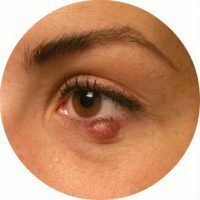
Barley is one of the most common infectious eye diseases in adults and children, about 85% of the population are affected during their lifetime. Inflammation is determined by visual examination of the affected organ of vision. Barley on the eye can not be perceived only as an ordinary cosmetic problem. From the degree of damage to the eye and properly selected medications, it will depend on how quickly and effectively the course of treatment is carried out. However, it can be quickly cured at home with the help of folk remedies.
- reasons
- Symptoms
- Types
- How dangerous
- Pharmacotherapy
- Chloramphenicol
- Sofradeks
- tetracycline ointment
- Tobrex( Tobropt, Dilaterol, Tobrosopt)
- Floksal( Danz, Unifloks)
- Tsiprolet( Ciprofloxacin, Rotsip, Tsipromed)
- erythromycin ointment
- Popular remedies
- Warmings
- Gadgets
- Garlic, onion
- Potatoes
- Aloe
- Propolis
- Salt, soda
- Tea
- Castor oil, glycerin
- For the child
- With the birch
Causes of
Barley appears on the eye when an infectious agent enters the follicle of the ciliary hair or the sebaceous( meibomian) gland. This occurs when non-compliance with hygiene standards, for example, when using someone else's or dirty towels for the face or cosmetics belonging to another person. To bacteria-pathogens are staphylococcus aureus and streptococcus.
Also the causes of the appearance of barley on the eye are called avitaminosis, hypothermia, weakening of immunity and problems with the digestive system. Creates a favorable environment for the development of barley demodicosis - a disease caused by tick-borne demodex, inhabiting the skin, and blepharitis is a chronic inflammatory disease of the eyes.
to table of contents ^Symptoms of
Inflammation of barley on the eye develops as a series of successive stages:
- Itching and burning in the ciliary region of the upper or lower eyelid is one of the first signs of the disease.
- The next stage is redness, after which swelling begins.
- Enlarged lymph nodes can also be a symptom of barley.
- At the end of the inflammatory process( about a few days), an abscess appears on the site of the pruritus.
In some cases, the disease is accompanied by fever and a headache.
Types of
Barley on the eye is of two kinds: external and internal.
- With the external , the malleus glands that develop a secret that protects the eye surface are inflamed. If the gland in the root of the eyelashes is clogged with its own fat secret, then the inflammatory process begins, which is marked by edema on the eyelid.
- The medical name internal barley on the eye - meibomite. It begins as a result of blockage of the sebaceous( meibomian) glands located in the thickness of the century. With inflammation in the inner age, the cartilaginous plate of the century itself suffers.
Barley can manifest itself in the form of a single eruption or numerous formations on one or both eyes at once. In the second case, the infection spreads from one ciliary follicle to another.
to the table of contents ^Than
is dangerous. An independent diagnosis and, accordingly, improper treatment may be more dangerous than inflammation itself. Simple barley can be confused with haljazionom or a cystic neoplasm, and methods of treatment like urinotherapy, warming up or squeezing will only aggravate the course of the disease.
If an abscess is squeezed out or the treated area is treated incorrectly, the infection can get into the blood, which will lead to sepsis and meningitis.
to the table of contents ^Medication treatment
When the first signs of barley appear on the eye, you should consult a doctor who examines the sore eye and tells you what means to process it. When treating medication, it is worth sticking to the prescribed course of treatment so that the result is as effective as possible. With the help of antibacterial drugs, the growth of bacteria causing inflammation is suppressed, as well as microbial cells are destroyed.
to contents ^Levomycetin
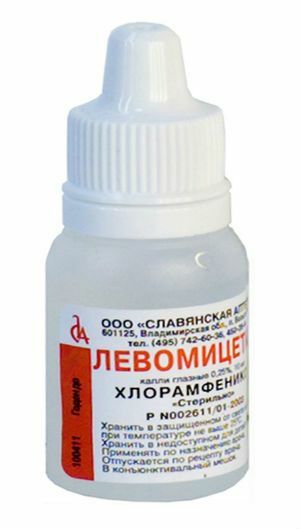
The active ingredient is chloramphenicol. Produced in the form of ointment and eye drops.
The bactericidal agent is able to penetrate the cells of the microbe and break the synthesis of the protein, stopping the formation of the pathogenic flora.
Side effects: minor allergic reactions.
Sofradex
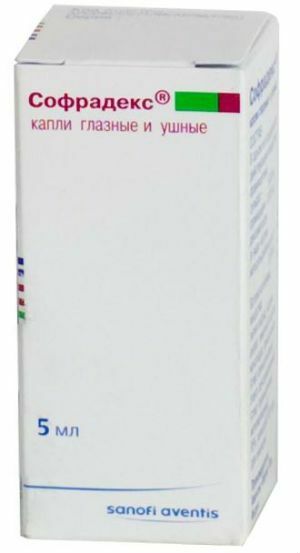
The active ingredient is gramicidin C, dexamethasone, and scramicetin.
Antibacterial agent is recommended for the treatment of barley in children and adults. The course of treatment usually does not exceed 7 days, but can be prolonged on the recommendation of a doctor.
1-2 drops are added every 4 hours to the conjunctival sac.
Side effects: allergic reactions, during the course of treatment for more than 7 days, intraocular pressure may increase.
Tetracycline Ointment

The active ingredient is tetracycline.
Antibacterial drug from barley on the eye is laid on the night for the lower eyelid. Due to the consistency and color of the medication, eyesight can deteriorate during the day. The duration of treatment is determined by the doctor.
Side effects: allergic reactions.
Tobrex( Tobrept, Dilaterol, Tobrosopt)
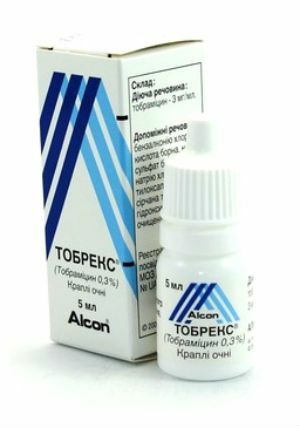
The active ingredient is tobramycin. Produced in the form of ointment.
The drug refers to antibiotics and is used to treat barley and other diseases provoked by bacteria. During pregnancy and lactation is used only if the potential benefit to the mother exceeds the risk of side effects in the fetus.
Side effects: headache, lethargy, nausea, anemia, pain in the place of application, allergic reactions.
Floxal( Danzil, Uniflox)
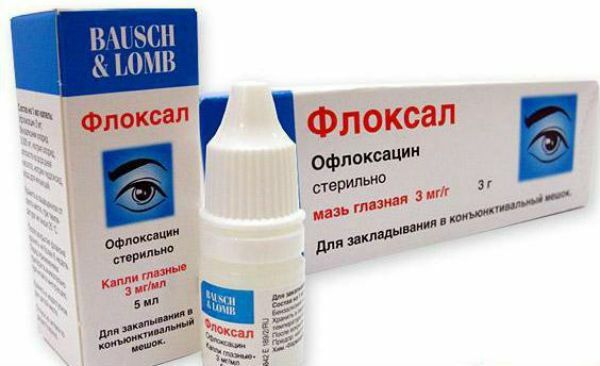
The active ingredient is ofloxacin. Produced in the form of eye drops and ointments.
It is used alone or in combination with other medicines. The drug significantly reduces the growth of bacteria - pathogens of barley.
Ointment is applied by a strip of approximately 1.5 centimeters to the lower eyelid 2-3 times a day. During treatment, slight deterioration of vision is possible. It is also not recommended to use contact lenses until the course of treatment is completed.
Side effects: burning sensation, discomfort in the eyes, itching and dryness, lacrimation.
TSiprolet( Ciprofloxacin, Rotsip, Tsipromed)
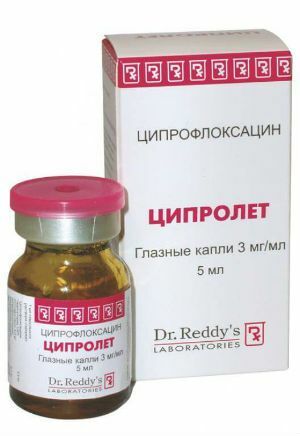
The active ingredient is ciprofloxacin. Produced in the form of tablets and eye drops.
Antibacterial eye drops can quickly and easily remove inflammation. Ciprolet is used alone and in complex therapy. Apply locally 1-2 drops in the conjunctival sac every 4 hours.
Side effects: itching and burning, painful sensations, lacrimation and allergic reactions.
Erythromycin ointment

The active substance is erythromycin.
Has a pronounced bactericidal effect.
Ointment is applied to the lower eyelid 2-3 times a day. The general course of treatment lasts an average of 14 days.
Side effects: itching, burning and redness.
Folk remedies
An alternative to drug treatment of barley is folk medicine, at home, it is suitable for ordinary food and simple methods of processing.
to the table of contents ^Warm up
One of the most popular folk methods for treating barley is warming up with a pre-cleaned warm boiled egg. For efficiency to be greater, the procedure must be repeated every hour.
Still it is possible to warm up barley on an eye dry heat. To do this, you need to take a flax seed, heat it in the oven, then fill a small bag that needs to be applied to the site of inflammation.
The inflamed eyelid warms up and with the help bactericidal lamp for 10 minutes 4 times a day.
to table of contents ^Gadgets
Positive effect is also provided by warm lotions using a filter pack of bactericidal herbs: calendula, chamomile, string, eucalyptus and sage. During the day the procedure is repeated at least 3-4 times a day.
to the table of contents ^Garlic, onions
Garlic in boiled or fresh form is in demand in folk treatment of barley.
Fresh garlic cloves are applied by cut to the eyelid in the place where the abscess starts to form. Keep garlic for no more than 15 minutes 3-4 times a day.
If boiled garlic is used, it must be kneaded to the state of gruel, wrapped in gauze and applied to the sore eyelid.
For onion and disinfection, the onions are also fried to lightly soften.
to contents ^Potatoes
The folk method of potato treatment relieves pain and swelling in inflammation. Before the procedure, prepare potato paste with a little water. The resulting mass is wrapped in a clean cloth applied to the inflamed eye.
to contents ^Aloe
Freshly squeezed aloe juice is effective in treating barley. Dipped in a juice napkin you need to handle the place where there was redness and began to appear abscess.
to contents ^Propolis
At the first signs of barley, it is necessary to treat the eyelid 4-5 times a day with alcohol tincture of propolis.
to contents ^Salt, soda
Barley is also treated with soda boiled in boiling water or salt heated in a skillet and folded into a small tissue pouch.
to table of contents ^Tea
At the first signs of barley, and also after the breakthrough of the abscess, black or green tea without additives will be an indispensable antibacterial agent. Washing is done with a piece of sterile cotton wool soaked in cold and very strong brew.
to contents ^Castor oil, glycerol
For home treatment, normal glycerin is suitable, which is applied inside the eyelid.
Castor oil is also used for compresses on sore eyes. The dressing is done at night, and the result is guaranteed after 2 days of application.
to contents ^Child
At the first sign of barley, the child consistently performs all necessary procedures to prevent the appearance of inflammation on the eye.
First, dry heat is used, that is, heated flax seeds collected in a bag are applied to the inflamed area. Then, using a piece of cotton wool soaked in alcohol, the brewing barley is cauterized. Effective cope with the inflammatory process and a remedy such as Dexamethasone.
From medicines for the prescription of the doctor Hydrocortisone and Tetracycline ointments are used, which are laid down for the lower eyelid 3 times a day, as well as eye drops of Sofradex. To cure barley under the eye, the doctor can additionally prescribe medications such as immunomodulators.
to the table of contents ^In pregnancy,
Barley on the eye during pregnancy is treated with extreme caution. First of all, the place of redness and itching can be gently processed with iodine so that the product does not get on the mucous membrane of the eye. The main treatment with drugs and the duration of the course is prescribed by the doctor.
If the abscess breaks, then it must also be lubricated with iodine. Next, tetracycline ointment is placed behind the eyelid. All procedures are carried out as neatly as possible so that the infection does not get on the mucous membrane. It is possible to wash barley by welding ordinary black tea without additives, which has bactericidal action. The thicker the welding, the better.
A doctor can prescribe antibacterial drugs if barley has become highly inflamed and symptoms such as fever, pain, and enlarged lymph nodes have been added. Antibiotics are buried inside the eye in the inner corner.
